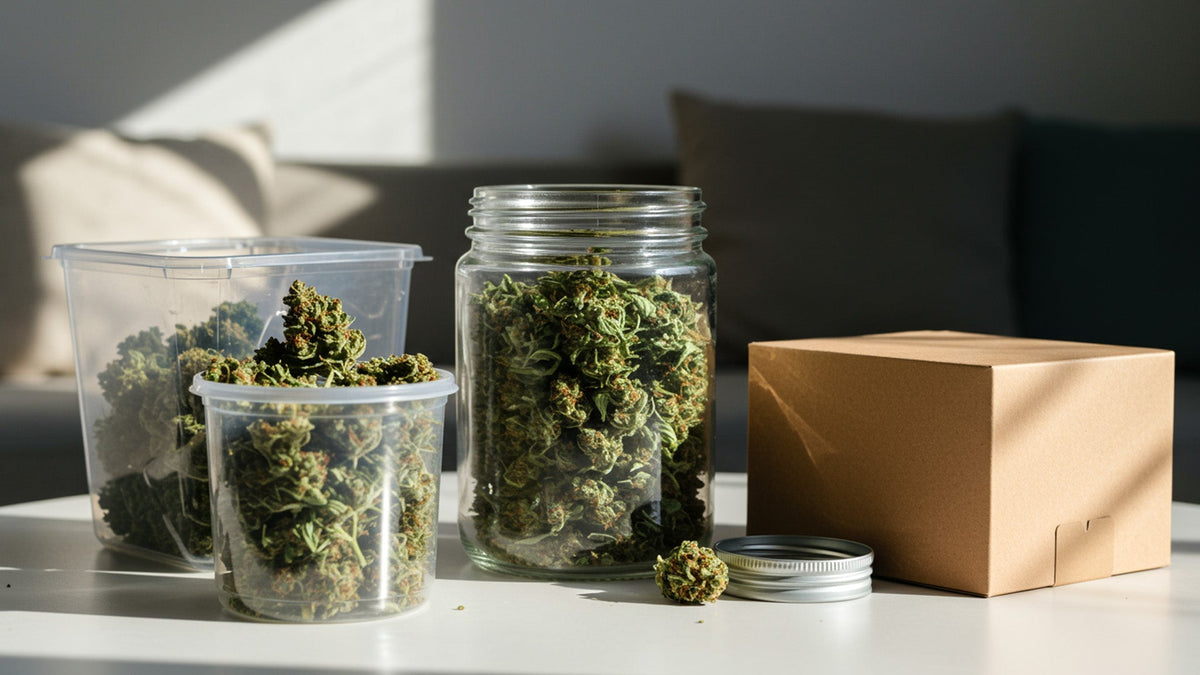
How to Store THCP Flower: Guide
|
|
Time: 5 min
Are you 18 years old or older?
I hereby declare that I am over 18 years of age and I also declare that I am aware that the following pages contain information about cannabinoid products.
Sorry, the content of this store can't be seen by a younger audience. Come back when you're older.
|
|
Time: 5 min
Proper THCP flower storage is critical for preserving the quality of high-potency cannabis products. Without careful handling, heat, light, and humidity can degrade key compounds like THCP, leading to reduced effects and flavor. This guide simplifies the science of storage to help enthusiasts maintain freshness and maximize their experience.
Unlike traditional THC strains, THCP offers a stronger effect due to its unique molecular structure. This makes precise storage methods even more vital. Exposure to air or improper temperatures risks altering its chemical profile, diminishing both aroma and therapeutic benefits.
This article outlines practical, research-backed strategies tailored for today’s cannabis market. Readers will learn how to store THCP flower, by choosing airtight containers, controlling environmental factors, and applying techniques validated by lab studies. Each recommendation prioritizes ease and accessibility, aligning with European climate considerations.
Whether storing your cannabis products for short-term use or long-term preservation, these methods ensure consistency. By focusing on evidence-based practices, users can avoid common pitfalls like mold or dryness. Let’s explore how small adjustments in storage habits lead to lasting quality.
Table of Content
In the evolving cannabis market, certain products stand out for their distinct characteristics. One such innovation is a cannabinoid with a molecular structure that binds more effectively to receptors than traditional THC. This compound, backed by recent research, offers enhanced potency and longer-lasting effects, appealing to both wellness-focused users and seasoned enthusiasts.
Unlike conventional THC, THCP interacts with the body’s endocannabinoid system more intensely. Studies suggest its elongated side chain allows stronger receptor binding, amplifying psychoactive and therapeutic outcomes. For example, lab tests indicate effects may last up to three times longer than standard Tetrahydrocannabinol (THC) strains.
Optimizing your THCP flower storage conditions goes beyond basic preservation—it’s about safeguarding a product’s unique properties. Even minor oversights in temperature or container choice can alter its chemical balance, affecting both potency and sensory appeal. Let’s break down the core factors influencing quality retention.
Consistency is key. Research shows cannabinoids like Tetrahydrocannabiphorol (THCP) degrade fastest when exposed to heat above 21°C or humidity outside the 55-62% range. Fluctuations trigger oxidation, reducing the effects users expect. For example, a 2023 study found unstable environments decreased potency by 23% within six weeks.
Cannabis enthusiasts in Germany and other European countries often face seasonal humidity shifts. Airtight containers paired with silica gel packs counter this. One user noted, “Storing my strain at 18°C with 58% humidity kept its aroma intact for eight months.”
Not all containers are equal. Glass jars with rubber seals outperform plastic by blocking UV light and air exposure. Opaque materials like amber glass prevent light degradation, preserving delicate terpenes responsible for flavor and effects.
Lab tests highlight vacuum-sealed stainless steel as optimal for long-term cannabis flower storage. These prevent moisture buildup, a common issue in Europe’s variable climates. As one review states, “Switching to UV-blocking jars doubled my strain’s shelf life while maintaining its earthy notes.”
Adapting storage methods to different timelines ensures your THCP flower maintains its unique qualities. Short-term solutions prioritize accessibility, while long-term plans focus on stability. Let’s explore how to balance both without compromising potency or sensory appeal.
For daily use, airtight glass jars in cool, dark spaces (18-21°C) work best. These prevent humidity shifts common in European households. Long-term storage demands stricter measures—vacuum-sealed containers in refrigerators (4-7°C) slow oxidation by 60%, per 2023 lab tests.
Method |
Duration |
Key Advantage |
Glass Jars |
1-3 Months |
Easy access, blocks UV light |
Vacuum Seals |
6+ Months |
Prevents moisture buildup |
Refrigeration |
12+ Months |
Slows degradation |
Summary: For short-term use, store products in airtight glass jars at room temperature. For long-term storage, vacuum sealing and refrigeration help preserve potency and prevent degradation.
Minimize light exposure to protect terpenes responsible for aroma. Integrate humidity packs (58-62% RH) to prevent brittleness. A Munich-based reviewer noted, “Storing my strain with Boveda packs kept its citrus notes vibrant for months.”
German cannabis enthusiasts highlight amber glass jars as game-changers.
One shared, “Switching from plastic doubled my product’s shelf life.”
Others caution against freezing, which can rupture trichomes. For edibles or oil-infused products, refrigeration remains the gold standard.
Maintaining cannabis flower’s quality requires more than basic care—it demands precision. As research shows, cannabinoids like THCP degrade rapidly when exposed to heat or light. Proper storage preserves their unique ability to bind with the body’s receptors, delivering stronger effects than traditional THC.
Users can preserve potency and aroma by storing products in airtight containers at stable temperatures (18-21°C). Controlled humidity levels (55-62%) prevent mold while keeping terpenes intact. Many cannabis users often pair amber glass jars with humidity packs for optimal results.
Feedback from experienced users confirms that vacuum-sealed storage extends shelf life significantly. Scientific data also supports refrigeration for long-term preservation. These methods align with Eruope’s evolving cannabis regulations, prioritizing safety and quality.
By applying these strategies, consumers enhance their experience while safeguarding their investment. For personalized guidance, trusted service providers offer lab-tested solutions. Prioritizing evidence-based storage ensures every use delivers the intended benefits.
Exposure to light, heat, or oxygen breaks down cannabinoids like THCP and THC, reducing their effects. High humidity can also promote mold, while low humidity dries out terpenes, altering aroma and flavor.
Plastic bags are unsuitable for extended periods. They trap static, crush delicate trichomes, and allow air exchange. Opt for amber glass jars or vacuum-sealed containers to preserve quality.
A muted aroma, brittle texture, or uneven coloration suggests degradation. Mold appears as white fuzz, while a musty smell indicates excess moisture. Discard compromised products immediately.

